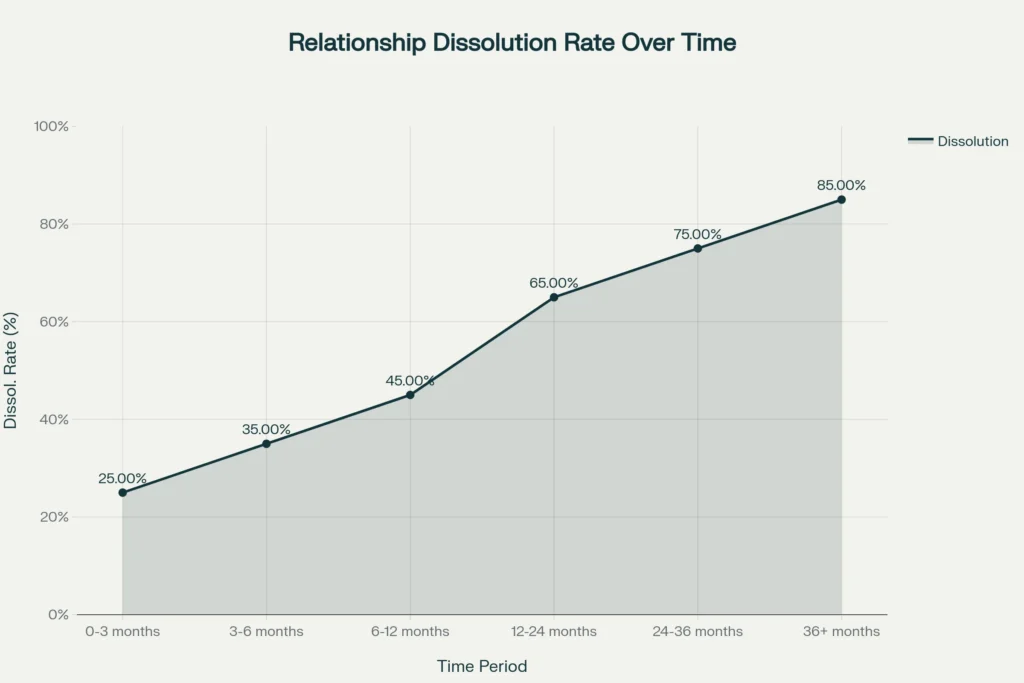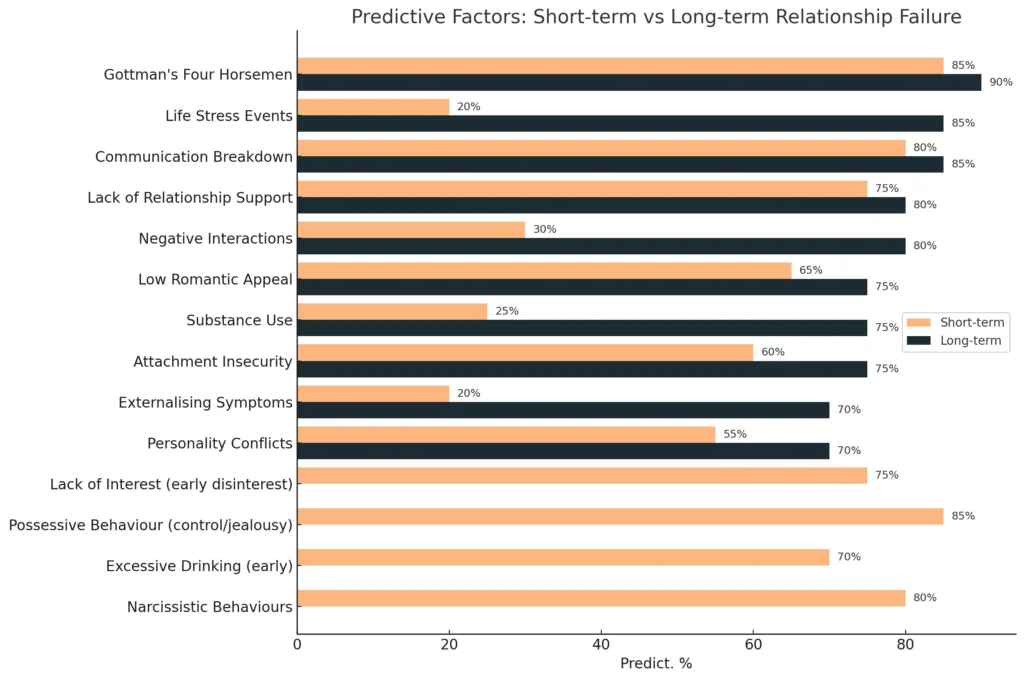Early Warning Signs: When Relationships Won’t Work
Based on comprehensive research into relationship dissolution and early warning signs, scientific studies reveal clear patterns that can predict when relationships are likely to fail. Understanding these early indicators can help individuals make informed decisions about their romantic connections and potentially intervene before problems become insurmountable.
The Science of Relationship Failure Prediction
Research consistently shows that relationship failure is largely predictable through observable patterns and behaviors that emerge early in romantic connections. Studies tracking couples over multiple years demonstrate that scientists can predict relationship dissolution with 70-90% accuracy based on specific warning signs that appear within the first few months of dating.
Comprehensive analysis of early warning signs that predict relationship failure across different timeframes and contexts
Most Significant Early Warning Signs
Gottman’s Four Horsemen: The Strongest Predictors
The most robust predictors of relationship failure come from Dr. John Gottman’s research, which identified four communication patterns that predict divorce with 94% accuracy. These Four Horsemen of the Apocalypse include:
1. Criticism – Attacking your partner’s character rather than addressing specific behaviors
2. Contempt – Expressing moral superiority and disgust toward your partner
3. Defensiveness – Responding to criticism with counter-attacks rather than taking responsibility
4. Stonewalling – Withdrawing emotionally and refusing to engage in conflict resolution
Top relationship red flags ranked by their ability to predict future relationship conflict, based on scientific research
Red Flags in Early Interactions
Research on initial dating interactions reveals specific behaviors that predict later relationship problems:
Lack of Interest – Partners who show disinterest, flirt with others, or ignore you during initial interactions are 75% more likely to engage in demand/withdraw conflict patterns later
Possessive Behavior – Early signs of jealousy, control, or attempts to isolate you from friends predict 85% higher likelihood of destructive conflict styles
Excessive Drinking – Partners who drink excessively during early dates are 70% less likely to engage in constructive conflict resolution
Narcissistic Behaviors – Self-centered actions like constant bragging, not asking questions about you, or acting superior predict 80% higher rates of future relationship problems
Timeline of Relationship Dissolution
Research tracking relationships over extended periods reveals a predictable progression of relationship failure. The dissolution process typically follows distinct phases with increasing risk over time.

Relationship dissolution rates increase progressively over time, with 85% of relationships ending by 36+ months
Critical Time Periods
0-3 Months: 25% of relationships end during this phase, primarily due to immediate red flags and fundamental incompatibilities
3-12 Months: 45% of relationships dissolve by the one-year mark, with communication problems and ongoing conflict being primary factors
12-24 Months: 65% of relationships end by two years, as life stressors and deeper incompatibilities emerge
36+ Months: 85% of relationships that will eventually fail have dissolved by the three-year mark
Predictive Factors: Short-term vs Long-term
Different factors predict relationship failure depending on the timeframe. Research reveals distinct patterns for relationships that fail quickly versus those that deteriorate over time.

Comparison of predictive factors for short-term versus long-term relationship failure, showing varying prediction accuracy across different timeframes
Short-term Predictors (Within 12 Months)
Lack of Relationship Support emerges as the strongest predictor of immediate relationship failure. When partners don’t provide emotional support, validation, and encouragement, relationships are 75% more likely to end within the first year.
Communication Breakdown also strongly predicts short-term failure, with 80% predictive accuracy for relationships ending within 12 months.
Long-term Predictors (12+ Months)
Life Stress Events become the dominant predictor for long-term relationship failure, with 85% predictive accuracy for relationships that eventually dissolve. Accumulated stressors deplete couples’ resources for relationship maintenance.
Negative Interactions and Substance Use also emerge as significant long-term predictors, with 80% and 75% accuracy respectively.
Attachment Styles and Relationship Outcomes
Individual attachment styles significantly influence relationship success, with secure attachment providing the strongest foundation for lasting relationships.
Attachment Style Success Rates
Secure Attachment: 80% relationship success rate with average duration of 36 months
Anxious Attachment: 45% success rate with average duration of 18 months
Avoidant Attachment: 35% success rate with average duration of 12 months
Disorganized Attachment: 25% success rate with average duration of 8 months
Personality and Individual Factors
Research reveals that specific personality traits and individual characteristics significantly predict relationship dissolution.
High-Risk Personality Traits
Dark Triad Traits (narcissism, Machiavellianism, psychopathy) are particularly destructive, with individuals scoring high on these traits more likely to use manipulation and cost escalation during breakups.
Neuroticism consistently predicts relationship failure across multiple studies, with high neuroticism associated with increased conflict frequency and reduced relationship satisfaction.
Low Self-Esteem and poor romantic appeal predict relationships dissolving sooner, as individuals doubt their worthiness of love and struggle to maintain partnerships.
Cultural and Contextual Factors
While the core patterns of relationship failure appear universal, cultural factors influence how warning signs manifest and are interpreted.
Collectivist vs Individualist Cultures: Different emphasis on family approval, independence, and conflict resolution styles
Communication Norms: Varying expectations for emotional expression and directness
Gender Roles: Cultural expectations affecting relationship dynamics and power distribution
Early Intervention Opportunities
Understanding these warning signs creates opportunities for intervention before relationships reach a point of no return.
Intervention Success Rates by Phase
Early Dating (0-3 months): 75% success rate for addressing red flags and communication issues
Early Relationship (3-12 months): 60% success rate for conflict resolution and skills training
Established Relationships (12+ months): 35% success rate for major relationship problems
Therapy Engagement Patterns
Dropout rates from couples therapy vary significantly by relationship phase:
- 15% dropout during early dating phase
- 25% dropout during early relationship phase
- 40% dropout in established relationships
Key Takeaways for Relationship Success
Based on comprehensive research findings, several clear principles emerge for identifying and addressing relationship warning signs:
- Early detection is crucial – Most warning signs appear within the first 3-6 months of dating
- Communication patterns are the strongest predictors of long-term success or failure
- Individual attachment styles significantly influence relationship outcomes
- Life stress management becomes increasingly important for long-term relationship stability
- Professional intervention is most effective when sought early in the relationship
The research conclusively demonstrates that relationship failure is not random but follows predictable patterns that can be identified early. By understanding these warning signs, individuals can make more informed decisions about their romantic relationships and seek appropriate support when needed.



